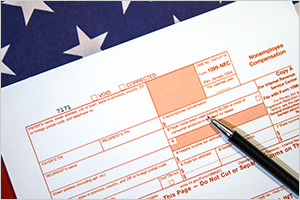September 15
- Filing deadline for 2024 calendar-year S corporation and partnership tax returns on extension
- Due date for 3rd quarter installment of 2025 estimated income tax for individuals, calendar-year corporations, and calendar-year trusts & estates
The One Big Beautiful Bill Act (OBBBA) passage does a lot to make expiring tax laws more permanent for 2026 and beyond. But it also makes substantial changes to the 2025 tax landscape.
This month’s newsletter covers some of the major changes impacting your taxes for this year and action steps to take to ensure you’re taking full advantage of the changes.
One article covers the new tax free tip and tax free overtime features in the bill, while a second article covers tax changes impacting families and their children.
Another article focuses on the main changes impacting businesses, both small and large.
Tip and Overtime Tax Breaks Require Your Attention
Best advice? Be prepared NOW!

Two new major tax changes, No Tax on Tips & No Tax on Overtime, are introduced in the One Big Beautiful Bill Act (OBBBA) passed on July 4, 2025. Here’s what you need to know about these two tax breaks, along with questions that still need answered before filing your 2025 tax return.
How much you can deduct
- No Tax on Tips. You can deduct up to $25,000 in qualified tips from your federal taxable income. The deduction phases out above $150,000 ($300,000 for joint filers).
- No Tax on Overtime. Up to $12,500 in qualified overtime pay can be deducted from your taxable income ($25,000 for those filing jointly). The deduction also phases out over $150,000 ($300,000 for joint filers).
Who qualifies
Obvious jobs such as servers and bartenders will likely qualify to deduct their tips. But there are plenty of other occupations who frequently or occasionally receives tips. The IRS is mandated to provide a more detailed list of what tips will qualify. Until this is done, there will be some uncertainty.
Regarding overtime, the tax bill uses the Department of Labor’s definition of working beyond 40 hours in a single workweek for non-exempt employees. The deduction only applies to the overtime portion of the pay (the one-half of time-and-a-half). But there’s still some gray areas. For example, what happens if a worker is compensated via a bonus or comp time instead of an hourly wage?
Reporting is key
Employers are required to separately report qualified tips and qualified overtime on an employee’s Form W-2 or a contractor’s Form 1099. The problem is that 1099s do not currently have a spot to report tips (the W-2 currently has a box for allocated tips), while both W-2s and 1099s don’t have a spot to report overtime.
There’s also withholding questions. While there’s a tax break for tips and overtime up to a certain dollar amount, this only applies to federal income taxes. Tips and overtime are still subject to other taxes, including Social Security, Medicare, and state income taxes. Employers will have to distinguish between income that’s fully taxable, and income that’s only subject to Social Security, Medicare, and other taxes.
2025 is a transition year
The OBBBA addresses some of this uncertainty by allowing 2025 to be a transition year before the tax-free income must be reported on reformatted W-2s and 1099s. And it’s a good thing because the 2025 format is already approved and been provided to printers and software companies.
More details to come
The IRS is mandated within the OBBBA to come up with what it will accept as proof of your 2025 earnings. Until that guidance is published you should:
- Immediately compile your overtime and tip income from the beginning of the year.
- Retain any documentation that can prove the amount you are going to claim.
- Review your pay stubs to see if tip and overtime income is tracked separately from your normal earnings. If so, you may have what you need. If not, contact your employer immediately and ask what they are planning to do to provide proper documentation.
The IRS says it will publish more guidance by mid- to late October. So stay tuned as these and other questions will hopefully be answered long before you must file your 2025 tax return.
What the New Tax Bill Means for Parents
Deductions, credits and more

The One Big Beautiful Bill Act of 2025 (OBBBA) contains a number of tax breaks for parents. Here’s a summary of what’s in the bill for families, including planning tips to make the most of each tax break.
- Parents get a permanent increase to the child tax credit. The child tax credit increases to $2,200 (up from $2,000) and is now permanent. The refundable portion stays at $1,700, with future adjustments tied to inflation.
- Planning Tip: If your adjusted gross income will approach $200,000 (single) or $400,000 (married), look for ways to reduce your income to avoid phasing out the credit. Strategies like contributing more to retirement accounts, health savings accounts, or flexible spending accounts can help keep you below the limit and maintain your eligibility for the full credit.
- Student loan cancellation is tax-free. Forgiveness of student loans due to death or permanent disability is now permanently excluded from taxable income.
- Planning Tip: Review disability paperwork for accuracy and ensure it is completed and submitted through the appropriate loan service office or the Department of Education’s Total and Permanent Disability discharge process. If you’re a parent borrower (such as with a PLUS loan), consider including this tax benefit in your estate or disability planning discussions.
- Adoption tax credit. $5,000 of the $17,280 adoption tax credit in 2025 is now refundable, even for families with little or no income tax liability.
- Planning Tip: To take full advantage of the non-refundable portion of the credit (up to $12,280), you’ll need to have a tax liability. Consider delaying certain deductions or, if possible, shifting taxable income into the year you claim the credit so you can take advantage of the non-refundable portion of the credit. But remember that the credit starts to phase out at $259,190 of income.
- Trump accounts. Each child born between January 1, 2025, and December 31, 2028, will receive a $1,000 tax-advantaged investment account at birth. Parents, grandparents, and qualified organizations can contribute up to $5,000 per year, until the year before the child turns 18. Funds can be withdrawn starting the year the child turns 18.
- Planning Tip: There are still many unanswered questions about this new account and its related tax break. There are also other, and potentially better, options to save for your child, including Roth IRAs. So while we wait for more clarification, consider using alternative tax-free or tax-advantaged accounts for your child.
- 529 Education Plans. The annual limit for K–12 tuition withdrawals doubles to $20,000 per student beginning in 2026. These funds can now also cover books, tutoring, online materials, home school costs, and educational therapies for children with disabilities. 529s can also be used for post-secondary teaching certifications and trade programs.
- Planning Tip: While contributions to a 529 plan aren’t deductible on your federal tax return, you can front-load up to five years’ worth of the annual gift tax exclusion into a single year. The 2025 exclusion is $19,000, so you can contribute up to $95,000 (5 x $19,000) to a 529 plan per beneficiary (up to $190,000 if married).
The Real Price of School: What Back-to-School Lists Don’t Tell You

You’ve bought the pencils, notebooks, and glue sticks. You survived the school supply aisle and think you’re done. The truth is the upcoming school year’s costs are just getting started! Here’s some other elements of the school year’s true costs and how to stay ahead financially this upcoming school year.
- Field trips, activity fees, and the mystery of the suggested donation. Some schools frame field trip fees as suggested contributions. Translation: We really need this money but legally can’t require it. Other times it’s an after-school art program with a sliding-scale fee, or a club that requires a registration charge for a free event.
- What it costs: $10–$100 per trip or activity
- How to plan: Request a calendar of planned field trips and extracurricular activities early in the year if it’s not automatically shared. Spread out your budget across upcoming months to plan for the expense. And if you have problems making ends meet, ask the school if they have funds to assist in paying for these activities.
- What it costs: $10–$100 per trip or activity
- School lunches: Where costs stack up fast. Packing lunch every day takes time, energy, and negotiation (Yes, you have to eat something green). But school lunches aren’t always the cheaper alternative, especially if your child buys them regularly and grabs extras like snacks or drinks.
- What it costs: $2 to $5 per day, per child = Up to $100 per month, per child
- How to plan: Compare monthly costs of school lunches versus packing from home. If your child qualifies for free or reduced lunches, apply early. And if you’re packing meals, create a rotating plan of simple, budget-friendly lunches to avoid rushed, last-minute purchases or uneaten leftovers.
- What it costs: $2 to $5 per day, per child = Up to $100 per month, per child
- The sports and activities funds. Sports used to mean a ball and a team t-shirt. Now it’s custom gear, team jackets, tournament fees, and optional team bonding events. Even non-athletic activities like band, theater, or robotics, can create equipment costs, performance uniforms, or competition entry fees.
- What it costs: Anywhere from $100 to $1,000+ a season depending on the sport or activity
- How to plan: Before your child signs up, ask for a full-season cost breakdown. Factor in travel, gear, meals, renting band equipment and team contributions, in addition to the initial sign-up fee. And for younger kids, leverage slightly used equipment. This comes in handy as kids often outgrow spikes, skates and shoes before they wear them out!
- What it costs: Anywhere from $100 to $1,000+ a season depending on the sport or activity
- Smile! You’re spending again. Picture Day can introduce an order form that charges $50 for an 8×10 and some wallet-sized prints you don’t need. But you must also plan for things like the costs of a yearbook and holiday performance DVDs.
- What it costs: $30–$80+ per event per child depending on the package
- How to plan: Decide early what you actually want to keep and skip the rest guilt-free. You can always take your own photo on Picture Day and buy the digital download later (if it’s even slightly more affordable).
- What it costs: $30–$80+ per event per child depending on the package
Be prepared, not overwhelmed
The truth is that school is expensive even when it’s free. But it is possible to manage if you plan for the entirety of expenses, not just the ones printed on the supply list. Create a separate school year fund in your budget, track spending per child, and have monthly check-ins to adjust.
And most of all, remember: You don’t have to do it all, you just have to do what works for your family. Enjoy the new school year!
New Tax Law Lightens Compliance for Small Businesses

The One Big Beautiful Bill Act of 2025 (OBBBA) expands several business tax benefits while easing certain compliance obligations. Here’s a summary of the key provisions affecting small businesses.
- Form 1099. The reporting threshold for Form 1099-NEC and 1099-MISC moves from $600 to $2,000 after December 31, 2025. This threshold is to be indexed for inflation starting in 2027.
- Tax Planning Tips: Be prepared to update your accounting software to track vendor payments against the $2,000 threshold. This avoids unnecessary 1099 preparation and aligns with the new requirement. And while the reporting threshold is now higher, it’s still a good idea to collect W-9 forms from all vendors and contractors before issuing payments. This ensures you’re prepared in case payments exceed the threshold.
- Form 1099-K. The $600 reporting threshold scheduled to go into effect in 2026 is rolled back to the old threshold of $20,000, along with the dual requirement of 200 or more transactions.
- Tax Planning Tips: Don’t rely solely on receiving a 1099-K to report income. Many businesses won’t meet the new reporting threshold but are still legally required to report every dollar earned. If your transaction count is high, however, be aware of how quickly you might approach the 200 transaction mark. Also consider labeling business and personal accounts separately on platforms like Venmo and PayPal. Mixing funds could cause reporting errors, especially as platforms enhance their 1099-K tracking capabilities.
- Qualified Business Income (QBI) deduction. The QBI deduction of 20% is now permanent. There’s also a minimum deduction of $400 for taxpayers who have at least $1,000 of qualified business income.
- Tax Planning Tip: Most independent contractors and gig workers who receive Form 1099 are eligible for the QBI deduction. However, if your business is classified as an Specified Service Trade or Business (businesses in health, law, accounting, financial services and others) this tax break begins to phase out when your income exceeds $197,300 (single) or $394,600 (married) in 2025.
- Section 179 deduction and bonus depreciation. Businesses can use the Section 179 deduction to write off up to $2.5 million of qualifying property in 2025, up from $1.25 million under the previous law. If you’d rather use bonus depreciation, the ability to write off 100% of qualified property is reinstated as of January 19, 2025 through the end of 2029.
- Tax Planning Tips: Businesses can often use both Section 179 and bonus deductions in the same year. Section 179 is generally applied first, followed by bonus depreciation for any remaining balance. But remember, this deduction only relates to the timing of the deduction, not the total amount of the deduction.
These are some of the new tax bill’s provisions that will affect most businesses across the U.S. Please call to discuss these and other provisions from the new tax bill that may affect your business.
